As we have in the past, Directions Magazine divides the geospatial technology sector into three categories: Geospatial Solutions, Geospatial Data, and Location Determination.In addition, we also follow those companies that provide mainstream business technology solutions but have also released software that either analyzes, stores, or displays geospatial information.But, this article will only briefly touch on companies in Enterprise Computing, such as Microsoft, IBM, Oracle and SAP whose primary line of business is not geospatial information but who have had a significant impact on this sector, especially in 2005.We'll compare these stocks by the Dow Jones Industrial Averages (DJIA), which also limped to just a 1% gain for the year.Note that the graphs provided in this article (Figures 1-3, and 5) track the percentage gain or loss of the company over the 2005 calendar year. This type of chart offers a unique perspective on shareholder value, both peaks and troughs, rather than simply reporting stock prices.
Private Companies
Unfortunately, two companies that provide a significant impact on geospatial technology do not release financial information: ESRI and Bentley Systems.ESRI provides some basic information to its customers during its yearly user's conference but not in any great detail. Bentley, however, just recently release a report on its finances but it covered only information during 2004.Bentley reported revenues of $300 Million, a 17% increase over 2003, and an "organic" growth rate of 8% after adjusting for currency exchange rates and acquisitions.It has stockholder equity of $100 Million and its operating cash flow was $45 Million.
Geospatial Solutions
In this category (See FIGURE 1 below), I have included software and services companies.Three of the primary market drivers are included in this category: Autodesk, Intergraph, and MapInfo.Smaller, niche market companies are also included: Leica Geosystems, Analytical Surveys and Descartes Systems Group.
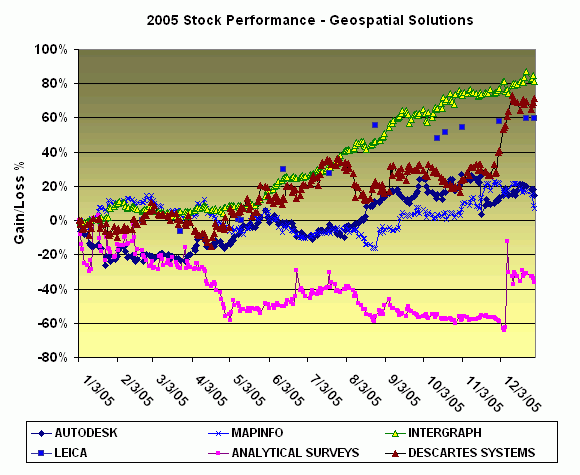
FIGURE 1
Intergraph had a stellar year increasing shareholder value by 81%. It realigned its operations into two divisions this year: Gerhard Sallinger was appointed as President of Intergraph's Process, Power & Marine (PP&M) division and Preetha Pulusani, formerly President of Intergraph Mapping and Geospatial Solutions was appointed as President of Intergraph's Security, Government & Infrastructure (SG&I) division.Jefferies and Company, issued a BUY rating on the stock last September and the stock appreciated over 20% since that time.Its trailing price to earnings ratio is 14.6, a relatively low number compared to the 32.7 average for the remainder of our portfolio.This generally suggests that the stock is still undervalued even at current price levels.
MapInfo finished the year with a lackluster performance with just a 7% gain overall, down from over a 20% gain that it had attained in just early December and 9% overall last year.In many respects, the company is a "pure play" in the geospatial technology field.It does not have any other division that is unrelated to some aspect of location-based information.While both Autodesk and Intergraph have divisions in mechanical design and other engineering support solutions, MapInfo's solutions suite is all alone in providing mapping software, data and services.But something isn't right.It has had quarterly average revenue growth of about 24% and it finished its fiscal year in September with a 47% revenue growth over 2004.The stock should be seeing double digit growth.So are the analysts missing something here?
Leica Geosystems, traded the Swiss Stock Exchange (SWX), shot up 62% this past year.The stock was bid up by the talk of acquisition. Hexagon, a Swedish company offered $788 million in cash and stock for Leica Geosystems last July but was then trumped by an offer of $925 million from Danaher, based in Washington DC.Hexagon eventually won this battle and is now in the process of integrating Leica into the fold.
For Analytical Surveys, it was a tough year, down 36%.According to bizjournals.com " Following another year of declining revenues, officials with Analytical Surveys Inc.(ASI) say they are pursuing alternative business strategies for the 40-year-old firm that provides data collection, creation and management services for the geographic information systems (GIS) markets." The net loss was $3.3 Million in 2005 or $1.26 per diluted share.
Location Determination
In the location determination sector (See FIGURE 2 below), there are three companies that offer primarily GPS equipment: Garmin, Thales, and Trimble.Garmin follows last year's 72% gain with a more modest 13% advance.Their stock was hit hard in spring and summer because revenues fell below analysts expectation.But then the stock rebounded significantly during the fall and is expected to keep its streak going after it reports results from the Christmas buying season where "anything GPS simply blew out the doors," according to James Cramer, RealMoney.com analyst.It must be true, I bought my first Garmin Forerunner 101 in September and I highly recommend it.But the real battle may be for personal, portable navigation devices (PND) such as the in-vehicle navigation systems.Prices have plummeted from over $1000 to just half that today.TomTom is doing some heavy advertising on radio and TV.Garmin joined the fray by launching TV ads with professional basketball star Yao Ming.
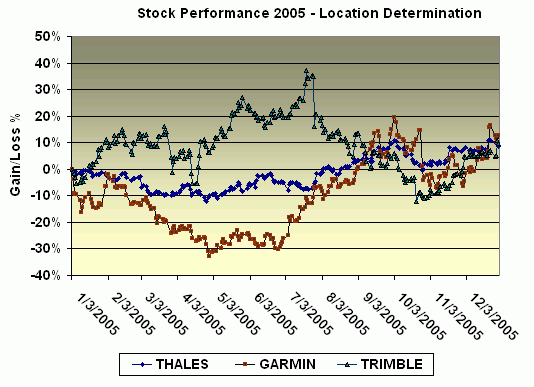
FIGURE 2
Thales Group, traded on the French exchange, gained 9% in 2005.Thales is a large multinational company engaged in everything from avionics and air defense systems to banking, homeland security and navigation. The company has revenues in excess of $10 Billion and a workforce of over 55,000.
Geospatial Data
The stock play in the geospatial data market is for in-vehicle navigation systems.That's where the money is today.GIS data purchases represent a small portion in the overall game plan of these companies. And next, the LBS market, still a sleeping giant for many, is the much hoped-for Holy Grail.Street centerline data is now a commodity; the next big thing is real-time data: real time gasoline prices; real-time traffic; real-time weather.These companies must lead the way if they are to increase their value to stockholder and parley their rich databases into the dynamic base of information that consumer will want.
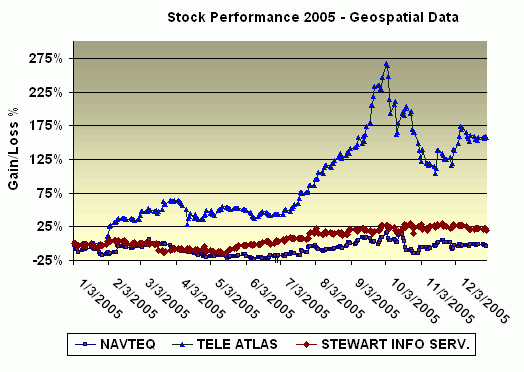
FIGURE 3
Tele Atlas, traded on the Geregelter Market of the Frankfurt Stock Exchange, won this year's award for greatest advance by skyrocketing 158% for the year.The company, like NAVTEQ vies for the in-vehicle market and counts TomTom, Michelen, and palmOne as a key strategic partners.The company estimates that the PND business is growing at 100% annually in the U.S.and 185% annually in Europe.In late October, the company announced that they had achieved a 56% growth in revenues for their third quarter equalling €50.5 Million compared to €32.3 million for the same quarter in 2004.In early 2004, Tele Atlas took down over $210 Million in financing from venture capitalist firms OAK Investment partners and NEA which it used to purchase GDT and grow its position in the LBS market.
Stewart Information Services Corporation, parent company of Stewart Title and GlobeXplorer is added to this category this year because of its breadth of data and information services.The company continued to add to its portfolio of geospatial data products with the acquisition of AirPhoto USA just this past September.It had acquired GlobeXplorer in January 2003.The stock price advanced 20% in 2005 but was downgraded to UNDERPERFORM in November by Keefe Bruyette.
FIGURE 4 below shows the overall results for the stocks in the geospatial market.
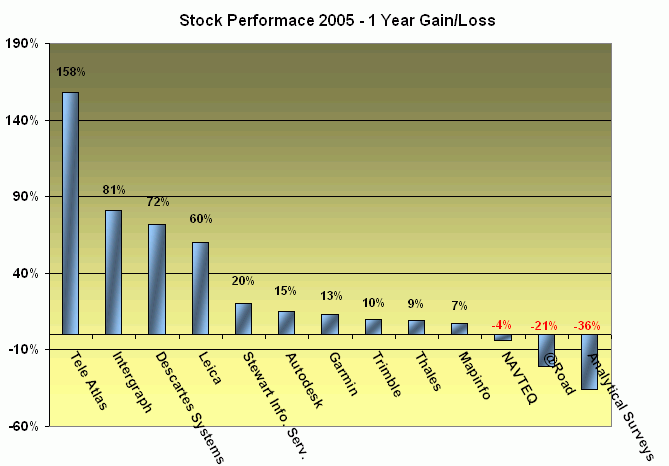
FIGURE 4
Enterprise Computing
In enterprise computing, the companies that are listed in our weekly stock portfolio do not count geospatial information as a core business.At best it is considered ancillary functionality in their product suites that allows them to retrieve another "arrow from their quiver" when dealing with key customers.Financially results show that only SAP had a small gain of 4%.Even an anemic Dow Jones Industrial Average (DJIA) gain of only 1% and a 6% gain on the NASDAQ, could not help the other enterprise computing companies which all lost value (See Figures 5 and 6).
In 2005, for example, Oracle continued to add functionality to Oracle Spatial, now a dominant leader in providing the ability to manage geospatial information directly within a relational database.Oracles acquisition of PeopleSoft (and as a consequence JD Edwards), and then Siebel Systems, provides them with an opportunity to reach a broad base of customers that need to manage information with a spatial component.Project Fusion will look to merge technologies form PeopleSoft and JD Edwards under a service oriented architecture (SOA).
Pitney Bowes, parent company of Group 1 Software, just this week announced a deal with Microsoft to embed their Geostan product into MapPoint Web Services and Microsoft Live Local for address standardization and matching.This is a significant win for Group 1 and the company will be looking to build awareness of its products with this development.
SAP launched a geospatial group within the company in 2005.Already a force in implementing GIS, SAP seems to be putting greater emphasis on location technology.But it is in the early stages of evaluating the market potential and is remaining somewhat silent on its plans at this time.A strategic partner of ESRI's for many years, SAP is in a battle with Oracle in the business intelligence market sector.
Microsoft continues a major push into mobile and web-based mapping.The launch of Virtual Earth, now renamed Live Local, is a competitor to Google Earth.The "leap frog" announcements in spring and summer of last year between the two companies will continue in 2006 as each tries to build "communities" of users who share location-based information via their web platform.Both are looking to "democratize" local information to be shared among its base of mobile users and raise the awareness of the social aspects of interactive communication through its web mapping portals.As an example of the ongoing competitive battle in which these two companies are engaged, Microsoft announced just this past week that it had acquired GeoTango, a company that offers 3-D visualization capabilities.
GE continues to focus on the utility sector and released new product enhancements for their Smallworld suite in 2005.In December, the company announced the availability of its Smallworld Analysis and Optimization* 4 (A&O) product for the electric utility design market.
IBM looks to carve a niche in spatio-temporal analysis.In a recent paper published by Directions Media's Location Intelligence Magazine, the discussion is focused on developing the time element as a key business driver.The author, David Beddoe states that, "The three categories where we offer spatiotemporal functionality lie in our Information Management, Rational and WebSphere portfolios.So, in addition to the database technology, which is the focus of this article, IBM offers spatial analytics access from the development and tooling environments of WebSphere and Rational, respectively, as well as location-based services implementation in WebSphere, implementing the OpenLS standard, for extending the information on demand infrastructure to mobile devices (WebSphere Everyplace Access)."
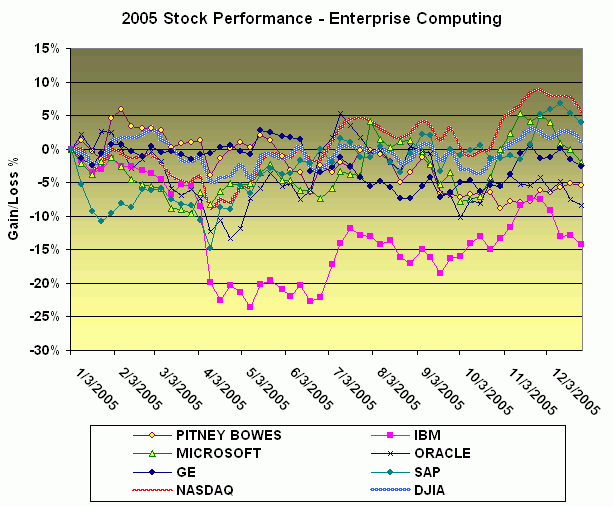
FIGURE 5
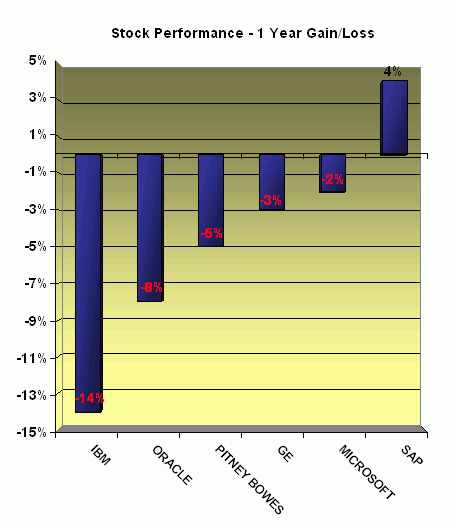
FIGURE 6
2005 may be mild compared to 2006.Intergraph will have to keep its growth curve moving by adding to its traditional customer base while MapInfo must do a better job of returning shareholder value given the revenue gains it is delivering.The location determination sector will be the one to watch as traditional GPS companies charge more aggressively into the consumer recreational market.And geospatial data companies look to add to their gains as the consumer appetite for location-based services such as in-vehicle navigation systems and handheld mobile devices will only increase.The enterprise sector will be dominated by companies who can convince customers that integrating location technology with business intelligence solutions will result in significant return on investment.It portends to be another wild year.